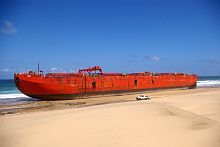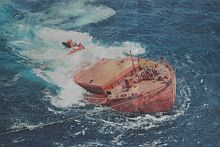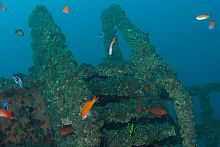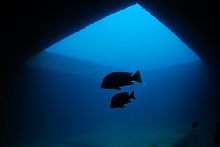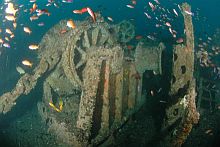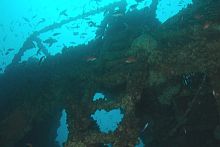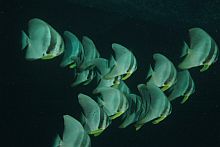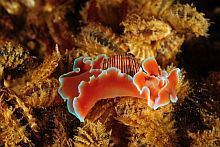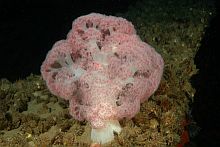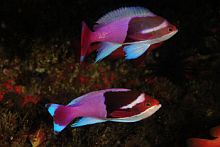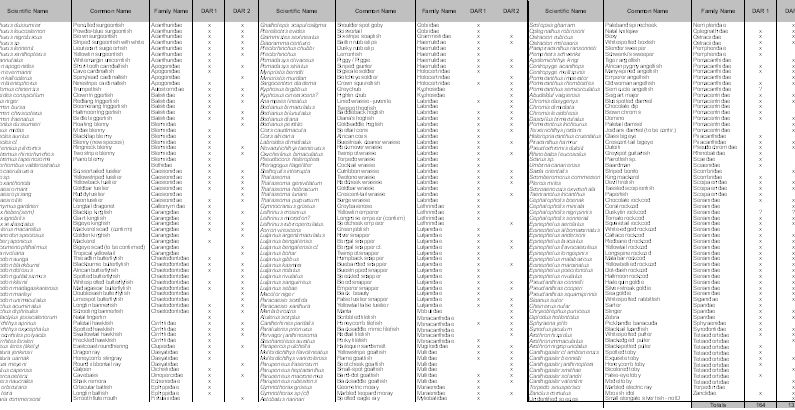Artificial reef monitoring in the iSimangaliso Wetland Park
|
In October 2008, two ocean-going cement transport barges (DAR 1 and DAR 2) ran aground on the beach at Cape Vidal in the iSimangaliso Wetland Park after their tow chains snapped during heavy seas.
The barges were declared a ‘total constructive loss’. Following a number of specialist inputs, arrangements were made to drag the two barges off the beach and scuttle them in deep water.
The iSimangaliso Wetland Park Authority decided to scuttle the barges within the iSimangaliso Wetland Park, but outside of the Marine Protected Area’s southern boundary, to create two artificial reefs. Reasons for this decision included dive opportunities as well as environmental, educational and research/scientific benefits. The reefs would also serve as new dive-sites to the region.
DAR 2 was scuttled in a depth of 40m in November 2008 and DAR 1 was scuttled 600m closer inshore in a depth of 26m a month later. Placement followed a bathymetric survey (study of underwater depth of lake or ocean floors) to provide the best depths and seafloor characteristics taking into account prevailing currents and other reefs in the area.
World Heritage Site
The iSimangaliso Wetland Park includes 9% of South Africa’s coastline extending 192 km from Maphelane in the south and Kosi Bay in the north. In 1999, the beauty and biological wealth of iSimangaliso (the name means “miracle and wonder”) was recognised by its listing as the first World Heritage Site in South Africa. iSimangaliso is one of the last areas in which the original plants and animals of South Africa can still be found as they were in ancient times. An astounding 2 505 types of plants, 1 258 species of fish and 521 bird species occur in iSimangaliso, many of which cannot be found anywhere else in the world.
iSimangaliso’s Cape Vidal is situated within the Marine Protected Area (MPA) approximately 30 kilometres north of the St Lucia Estuary in Kwazulu-Natal. The closest recreational scuba diving location within the park is found at Sodwana Bay, a further 70 kilometres to the north. Substantive natural coral reef complexes stretch from Sodwana Bay towards the south as far as Leadsman Shoal, but this portion of the coastline is prohibited to recreational scuba diving.
Artificial reefs vs natural reefs
The scientific literature indicates that artificial reefs carry a greater abundance, diversity and biomass of ichthyofaunal (fish life of a region) communities than natural reefs and as such serve as a major draw-card for sport divers. Benthic (the ecological region at the lowest level of a body of water such as an ocean) colonisation of artificial reefs has been shown to be rapid initially, but variable according to surface orientation.
SAEON’s Elwandle Node, following an open tender, has been appointed by the iSimangaliso Wetland Park Authority to document and monitor the biological colonisation of these wrecks over the long term. The research team consists of eight scientists and four citizen scientists, including the well-known fish taxonomist Dr Phil Heemstra and the popular author and underwater photographer Dennis King.
Diving on air is inherently limited by depth, which dictates the available bottom time for repetitive dives. Strong currents were an additional constraint that had to be factored into the sampling strategy. Consequently, longitudinal high-definition video transects had to be carried out in one direction as it was very difficult and sometimes impossible to swim into the current.
Invertebrate growth on the barges was documented by means of systematic quadrate photography. For this particular study area the video transect and quadrate photography methods purport to be preferred over direct assessment methods as individual diver bias (owing to the high number of species and densities) is eliminated and a video/photo leaves a permanent record for archiving and comparative analysis at a later stage.
A new species of blenny was found and is currently being described by specialists of the Smithsonian Institute in the USA. Results of this trip and future annual trips will allow us to document temporal changes in the artificial reef community. Moreover, researchers from the Department of Environment Affairs’ Marine and Coastal Management will get involved using various sonar tagging technologies to investigate the movement patterns of fish from and to the barges.
Related content:
Launch of exciting new ventures in marine research
Versatile new research vessel set to boost SA marine science
Complete species list of DAR 1 and DAR 2 so far. In all 195 species were recorded, including a new species of blenny.


